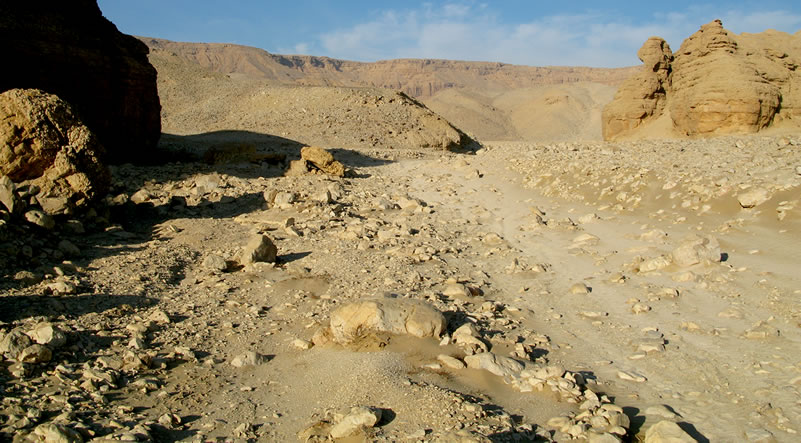The Rock Inscriptions of the Wadi Arqub al-Baghla
Archaeological material on the Darb Arqub al-Baghla is predominately of Predynastic, Protodynastic, and Coptic dates. A series of huts with considerable remains of late Predynastic pottery suggest that the Darb Arqub al-Baghla was probably the major route of direct access into the Western Desert for Naqada and her rulers.
The “Scorpion Tableau” at Gebel Tjauti, on the Wadi ‘Alamat Road, may reveal the use of the southerly track to outflank and avoid the desert patrols and watchmen of Naqada on the Darb Arqub al-Baghla at the dawn of Dynasty 0.1 The inscriptions closely associated with the tracks of the Wadi Arqub el-Baghla route concentrate in two major areas: 1) the “Crocodile Bay,” a small bay to the south of the tracks; and 2) the main concentration, at the head of a steep wadi within the main wadi. Most of these inscriptions are Predynastic and Coptic in date, the majority being relatively small.

Section A No. 2: A Crocodile and Water Fowl
This image of lines of birds2 beneath the larger images of a stork followed by a crocodile, recalls the decoration of the Davis comb and the Abu Zeidan knife handle,3 with images of a stork followed by a giraffe functioning as the heading to the second line in horizontal registers of animals, marching by kind. On the Carnarvon knife handle the same group of stork and giraffe also appears as a heading, the initial image of the stork there — as here in the Arqub Baghla image — omitting the serpent beneath the bird’s beak.4 This syntax of imagery, present in the iconography of a number of portable objects of the late Predynastic Period,5 may have been transferred to the symbolic repertoire of rock art, if it did not indeed already exist there. So in rows of animals marching in horizontal lines by kind, elephants — usually trampling or standing atop serpents — occupy the upper register; a bird with a serpent rearing beneath the beak heads the second register; a dog or a star may close a row of animals.

In the lines of animals that appear in late Predynastic imagery, the bird with serpent that may introduce the second register of animals appears to signify the triumph of order over chaos. On the Davis comb, a giraffe, the image of the solar cycle, follows the bird with serpent, the latter group symbolizing order. The probable significance of the group composed of 1) bird-with-serpent plus 2) giraffe is a compound proto- hieroglyphic writing of the concept of “triumph of solar order.” Such a reading of the compound finds support in the Scorpion tableau at Gebel Tjauti, where the bird-with- serpent appears as a label to an image of the mace-wielding ruler holding a bound enemy by a rope — at Gebel Tjauti, the alteration of the second element in the group of bird-with-serpent plus giraffe transforms the proto-hieroglyphic orthography of “triumph of solar order” into an annotated representation signifying the “triumph of human order.” The image of the ruler and his prisoner at Gebel Tjauti, labeled with the bird with serpent, appears to be the Predynastic equivalent of the heading to a group of New Kingdom loyalist hymns — “victory be to the ruler!”6 The reduction of the larger group of the bird-with-serpent with following giraffe into the giraffe with serpent on the vessel Berlin 15129,7 and the apparent omission of the serpent in the Arqub al-Baghla A2 image, and on the Carnarvon knife handle, suggest that the individual proto- hieroglyphic signs were well known within certain circles; the use of these images in rock art at desert road sites further implies that this knowledge was widely distributed, or at the very least that the practitioners of this proto-writing were well and widely traveled.
The specific meaning of the bird with serpent followed by crocodile is unclear, unless it specifies the triumphing power. An association of bird and giraffe with a mirroring group of crocodile and giraffe, appearing to confirm the association of the Arqub el-Baghla image with the groups of stork and serpent with giraffe, appears on the fragmentary palette Berlin 23301,8 on which a a bird (stork?) appears behind one of a pair of giraffes flanking a central palm, with a crocodile (facing a smaller bird) behind the back of the other giraffe. The absence of quadrupeds, and the exclusivity of birds in the registers here and in Arqub el-Baghla B1, are unusual, however, in comparison with the comb and knife handle. A line of birds appears, however, on a cylinder seal from Qustul.9
Notes
- 1. See Darnell, et al., Theban Desert Road Survey 1, pp. 6 and 18-19.
- 2. For the rows of apparent storks in Theban rock art, compare Sadek and Shimy, Graffiti 3/6, pl. 271, no. 3695.
- 3. Davis comb: Asselberghs, Chaos en Beheersing, pl. 28; Abu Zeidan knife handle: ibid., pl. 29.
- 4. ibid., pl. 32 [fig. 44]). The association of the bird with giraffe appears more subtly on the Two Dog and Four Dog palettes as well — Asselberghs, Chaos en Beheersing, pls. 70-73.
- 5. Bénédite, JEA 5 (1918): 225-241; Cialowicz, in Friedman and Adams, eds., Followers of Horus, pp. 247-258; Huyge, in Hendrickx, Friedman, Ciałowicz, and Chłodnicki, eds., Egypt at its Origins, pp. 823-836; Hendrickx, in Kroeper, Chłodnicki, and Kobusiewicz, eds., Archaeology of Early Northeastern Africa, pp. 723-749; repetitive lines of birds also appear in A-Group iconography — Williams, The A-Group Royal Cemetery at Qustul, p. 157, fig. 57, 239, fig. 89k, and pl. 9, fig. d; idem, Neolithic, A-Group, and Post-A-Group Remains, p. 20, fig. 5c, and 102, fig. 59f.
- 6. Epigraphic Survey, Reliefs and Inscriptions at Luxor Temple 1, commentary p. 35; Manassa, Great Karnak Inscription, p. 127.
- 7. Asselberghs, Chaos en Beheersing, pls. 17-19.
- 8. Asselberghs, Chaos en Beheersing, pl. 89, fig. 156.
- 9. Williams, A-Group Royal Cemetary, p. 157, fig. 57 (OIM 23848).
